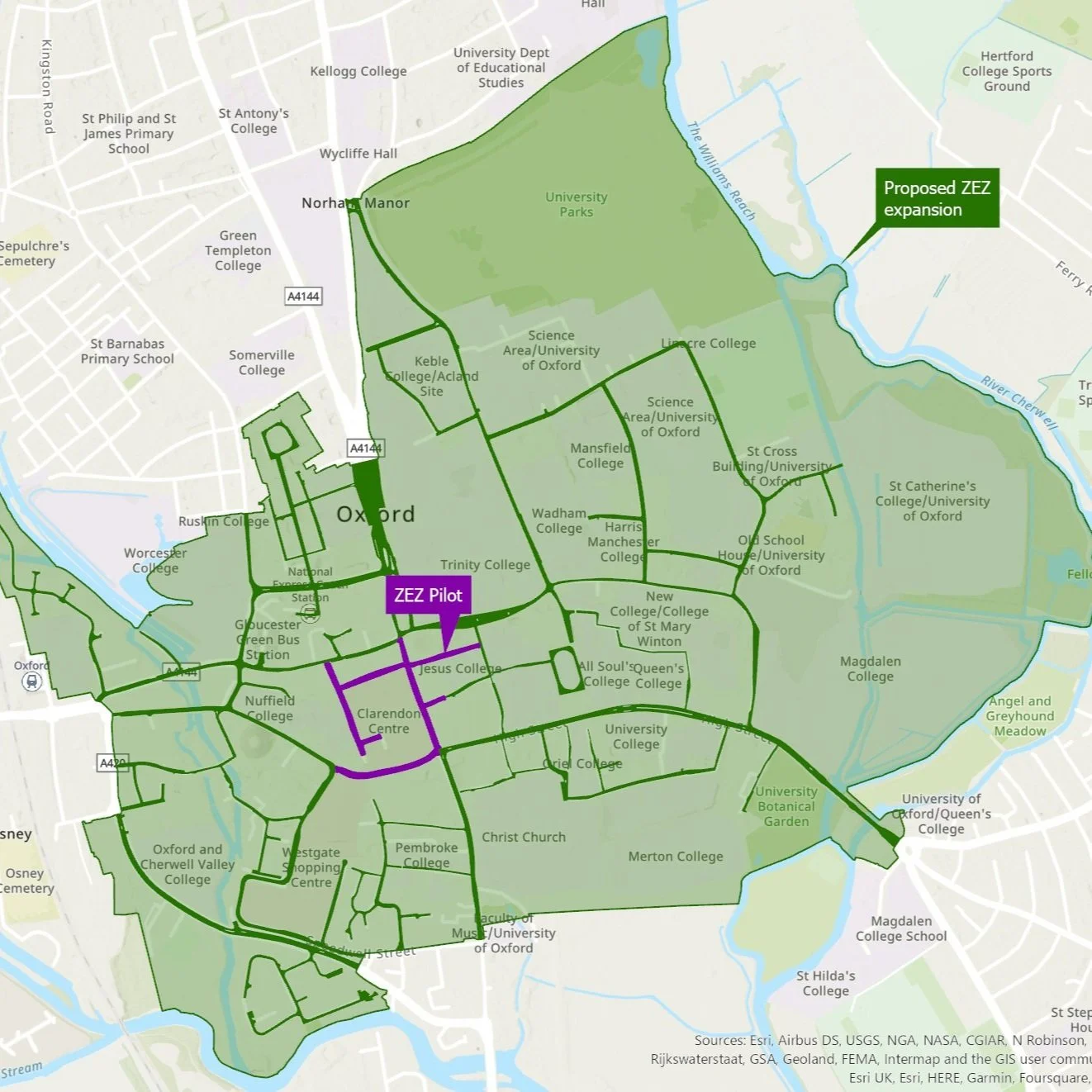
What’s Changing in Oxford?
Oxford’s travel policies have been changing lately. Learn more about policies already in place such as the temporary congestion charge, LTNs and current ZEZ as well as upcoming changes, such as traffic filters and expanded ZEZ and how they may impact your journey. You can also learn about what Oxfordshire is doing to make its roads safer for pedestrians and cyclists.
Temporary congestion charge
Oxford’s temporary congestion charge scheme came into force on 29 October, 2025.
The scheme aims to reduce traffic congestion while Botley Road is closed, improve bus services and make it easier for those with permits—community health and care workers, carers, blue badge holders and traders—to travel by car into and around the city.
Charges only apply to cars and those with a valid permit can pass the six charging points free of charge. A daily fee of £5 allows all other cars to go through the six charge locations until the end of the day.
Residents can apply for permits and free Park and Ride bus travel is available during the initial three months of the scheme.
The scheme is enforced using automatic number plate recognition cameras (ANPR) with traffic signs marking the locations of the charging cameras.
For full detail of the scheme and the charge locations, see the county council’s website.
Any surplus income generated by the scheme will be ringfenced for transport improvements and will subsidise Park and Ride services and improved bus services. You’ll find full details on improvements to bus services here.
Trial traffic filters
These will help reduce traffic and congestion, making buses quicker and more reliable and walking and cycling safer and more attractive. All the information about the trial filters is on the county council’s website. In summary:
The traffic filter trial will start once the Botley Road reopens. Network Rail has announced that they aim to reopen the road in August 2026. Keep an eye on the council’s website for updates.
The filters only apply to cars and have been placed so you can drive to every part of the city without going through a filter, but it might mean driving a different route than you normally would.
There will be no physical barriers, only cameras, like many car parks have now.
If you live inside Oxford or Oxfordshire, you will be able to apply for a free permit that means you can drive through all of the filters, as many times as you wish on 100 days (if you live in Oxford) or on 25 days (if you live in the rest of the county). Check out the council’s website for all the latest detail on available permits.
Anybody driving in a vehicle that is not a car can drive through the filter points whenever they like.
For more details about the filters, passes, and exemptions, please see the county council’s website.
Zero Emission Zone (ZEZ)
Any cars or vans can drive into the zone at any time, but unless they are electric, there will be a charge.
The charges are low for most modern petrol vehicles. For much older and diesel vehicles, it’s higher.
You can check your vehicle online to see how much you would need to pay.
You can pay before you go in, on the day, or up to six days after.
If you enter the zone and don’t pay the charge you’ll be fined.
All the money raised must be spent on other transport improvements like bus subsidies or better pavements.
There’s a discount for residents and businesses in the zone, health and care workers, blue badge holders and others.
Buses, taxis and emergency services are exempt from the charges.
The current ZEZ area is marked in purple on the map. It has been proposed to extend the ZEZ area to cover a greater amount of the city centre (marked in green on the map). This would only happen after a consultation and the date has not yet been decided.
See the County Council ZEZ pages for more details.
Low Traffic Neighbourhoods (LTNs)
LTNs are used to keep cars on main roads that were designed for more traffic, instead of on smaller roads with more people living on them.
Three LTNs were created in the Temple Cowley, Church Cowley and Florence Park areas of Cowley in 2021. Three more were created in the Divinity Rd, St Clement's and St Mary's areas of East Oxford in 2022.
Through traffic is prevented in the LTNs by the use of planters or bollards. All streets can still be accessed on either end of the planters/bollards. Specific keyholders, including emergency and waste services, can unlock the bollards to drive through.
Google Maps recognizes the LTN roads and will not route through them when giving driving directions.
On Divinity Rd, Magdalen Rd and James St in East Oxford, and Crescent Rd, Littlehay Rd and Littlemore Rd in Cowley, the planters/bollards have been replaced by ANPR cameras. Private motor vehicles are fined for driving past the ANPR cameras. Emergency services, waste and postal vehicles, buses and taxis/private hire vehicles are able to drive past the cameras without being fined.
See the County Council LTN pages for more details.
Vision Zero
Vision Zero aims to eliminate deaths and serious injuries from road traffic collisions in Oxfordshire.
In 2022, Oxfordshire County Council committed to achieve Vision Zero by 2050. In the interim, they aim for a 25% reduction in casualties by 2026 and a 50% reduction by 2030.
There are currently an average of 20 road deaths and 250 severe injuries each year in Oxfordshire.
Achieving Vision Zero will require changes in cycling and pedestrian infrastructure, speed management in partnership with Thames Valley Police, road safety education and training, and wider improvement programmes, including Oxfordshire County Council’s 20mph scheme.
Read more about Vision Zero here.
Updated November 2025





